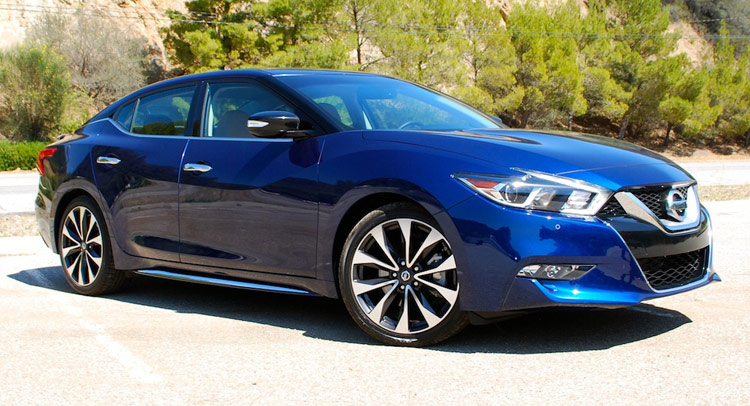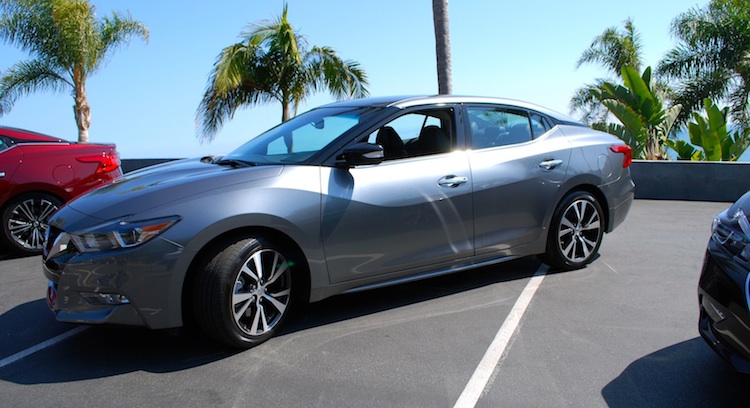“Is that some experimental car or something?”
Near Malibu, California, yesterday, a man in a parking lot came up to us and the 2016 Nissan Maxima to get a good look around the new car. He was intrigued and had to go around the back to see what kind of car it was.
“Wow, the Maxima’s come a long way.”
The Maxima nameplate, despite being overshadowed in sales by the smaller Altima and playing in the incredible shrinking segment of large mainstream sedans, still evokes warm memories for a lot of people. That’s one reason Nissan is so obviously playing up the car’s heritage as the “four-door sports car,” or 4DSC. It’s strategically placed in the lights on the new car and the Nissan marketing team has already been hitting us over the head with the acronym. Get used to it again.
“Four-door sports car,” though, has come to mean something different since the Maxima popularized the term in 1988 – cars like the Porsche Panamera, the Maserati sedans and a host of BMW Ms, Mercedes AMGs and Audi RS cars would rise to attention now.
So what does “4DSC” mean when applied to a 300-horsepower, front-drive V6 sedan in 2015?
Nissan understands the large mainstream sedan market is flooded with the conservative shapes of cars like the Toyota Avalon and Ford Taurus, as well as cars that try to liven things up like the Chrysler 300, Chevy Impala and Kia Cadenza.
So to stand out, they’ve thrown out all the stops to make it stand out. They’ve undoubtedly succeeded here. In practice, the 2016 Maxima is extremely faithful to the Nissan Sports Sedan Concept from the 2014 Detroit Auto Show.
I was a little unsure of it in brighter colors at the production car’s reveal in April at the New York Auto Show, but on the street and in blue and black, the shape works pretty well. Best of all, the more I look at it the less it looks like a squashed Nissan Murano. I’m still not sold on that black plastic trim at the back to make the “floating roof,” in design-speak.
It’s absolutely not to everyone’s tastes, but at least it’s different, so Nissan gets lots of points for trying.
Having already determined at the New York Auto Show that the new Maxima’s looks take a toll on passenger space in the rear, I was surprised to be really comfortable in the front. Headroom is plentiful and the seats have enormous range of fore-and-aft travel. Despite what Nissan’s research says about many Maxima owners having kids, this car feels like it was designed exactly for people without children or with children who refuse to be seen with them.
The Maxima’s interior design also feels much more like a two-person place. But it doesn’t feel confining, which is a neat trick that perhaps should be expected in a car this large. Nissan says the design was born from fighter jets, but it feels a bit like a BMW 6-series Gran Coupe. A 6-series on a tight budget, anyway.
While everything looks good, not all of it makes the luxury grade. Trim made to look like metal is so obviously plastic and had sharp edges to it. The center console lid squirms around when you open and close it. And the leather/Alcantara steering wheel on the sport-tuned SR trim had a squishy property to it, as if it were a built-in stress ball.
That aside, the Maxima is on par with the large sedan class for interior quality. The standard navigation system is presented on a fine 8-inch touchscreen that quickly responds to your prodding and dragging – some might say it’s like a smartphone! It’s accompanied by a 7-inch color display between the gauges that allows for a really big compass in the dash.
Perhaps the most welcoming part of the Maxima just how comfortable the front seats were. That “NASA-inspired Zero Gravity” marketing might not be a gimmick and the wide cushion and great range of adjustment means you can get comfortable in them without sinking into them.
The Dad Jokes about being an astronaut will be endless.
Nissan says it’s saved 82 pounds of weight in this redesign compared to the outgoing model, which still puts the 2016 Maxima right around 3,500 lbs. to start. That’s good for a full-size sedan, less encouraging for something that wants to rival a true sports sedan.
So it’s again surprising that the Maxima didn’t feel ponderous or severely hampered by its front-drive or heavy V6 sitting up front. Considering how long and imposing the car looks on the outside, it does a commendable job of concealing its size when tackling corners.
But even in the sportiest SR trim, the Maxima never felt eager on the roads above Malibu. While the engine pulls smoothly, it never feels like you’re going very fast and you wonder how many of the 300 horses showed up for work today. There was an effervescence notable by its absence.
Put it in Sport mode, the CVT’s love of revs doesn’t mean you’re hearing much from the engine. The enormous paddles on the steering column don’t add any more engagement. If anything, putting it back into Normal mode makes the engine a touch more coarse.
Where it did excel, however, was in horrible Pacific Coast Highway stop-and-go traffic. In addition to the extremely comfortable seats, the Maxima is a quiet car. Visibility is adequate considering the adventurous style outside. Even on the SR, with its 19-inch wheels and stiffened suspension, the ride was pretty plush. The best thing to do with this Maxima is put in drive, push the Sport button and watch the needle on the speedometer rise.
“I’ve got to tell my sister about this. She likes the Acura TLX and that Infiniti Q… 50?”
That man from the parking lot may not remember Infiniti’s nomenclature either, but Nissan execs probably want to find him and hug him right now.
Nissan says it sells more Maximas to retail buyers than any of its large sedan competitors, but that still means the company sells 50-60,000 of the cars per year. It’s hoping to be between 50,000 and 75,000 a year with this generation, and that’s harder to do as more full-size buyers find midsize crossovers like Nissan’s own Murano attractive.
Which is why the company is making a serious play for buyers who would normally get a basic-to-middling BMW 3-series, Audi A4 or, chiefly, the front-drive Acura TLX. As I’ve said before, if you have any common sense you’ll buy one of these large mainstream sedans over a badly equipped entry-luxury model.
On sale June 3, Nissan expects about half of sales to go for either the SR or Platinum models, which push right up against the $40,000 mark. The $37,715 SL comes with heated steering wheel, panoramic roof and full suite of safety tech, but even the base S model gets navigation at its roughly $33,000 starting price.
And to my eyes, the Maxima wins over the TLX because someone remembered to style it, rather than just add LEDs.
While the sports car aspect didn’t jump out at me, the 2016 Maxima is a promising reboot for the car that has built up a resilient reputation over 35 years. It would’ve been a crime for Nissan to relegate it to history, but they deserve credit for realizing the big, old front-drive sedan playbook isn’t working.
Now, can I get a box of those old “4DSC” window stickers from the dealer?
Nissan invited me to drive down to the Bel Air Bay Club in Pacific Palisades to have a go in the 2016 Maxima and eat their food and drink their beverages to, “wait out the afternoon PCH traffic.”
Photos: Zac Estrada/Carscoops.com































